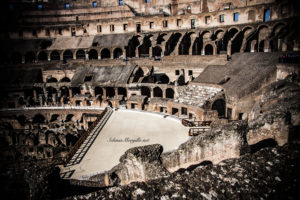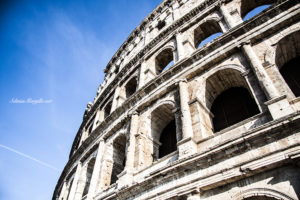Flavian Amphitheater or Colosseum
Italian Version below*
The ancients knew it as a Caesarean amphitheater in the sense of imperial or simply as a New Amphitheater. In the 8th century AD, the monk Beda was the first to call it the Colosseum.
How long the Colosseum will stay, Rome will also.
When the Colosseum collapses, Rome will also collapse.
When Rome collapses, the world will also collapse.
According to most, the name – Colosseo – derives from the presence of the bronze statue of Nero, made by the sculptor Zenodoro. It was about 35 meters high and was originally positioned in the vestibule of the Domus Aurea of Nero, coinciding with the place where the subsequently arose Temple of Venus and Rome. With Nero’s death, the project Domus Aurea stopped and was never completed.
The emperors of the Flavian dynasty restored the public function of the areas previously occupied by the Domus; in the area of the stagnum neronis was built the amphitheater.
The construction site began with the founder of the Flavii, Vespasiano, between 71 and 72 AD, who died in 79 AD, and did not see the final term of his ambitious project.
The inauguration took place in 80 AD under the government of Emperor Titus and Cassio Dione speaks of it: “Most of his achievements were not noteworthy, but when he inaugurated the hunting theater and the spas that bear his name It offered many grandiose shows. There was a battle between cranes, and also four elephants: wild animals and they were not killed until the number of nine thousand, and also women (certainly not those of importance) took part in the massacre. As for men, several they fought each other in single fights and several groups clashed, both infantrymen and sailors in naval battles. Because Tito suddenly filled that theater with water and brought in horses and bulls and other trained animals who were trained to stay in the liquid element as well as on earth. And he brought ships into it, with people impersonating the soldiers of Corfu against those of Corinth. “
… These were the shows offered, which lasted for a hundred days; but Tito also provided things of practical use for people. Every now and then he threw small wooden balls from the top of the theater, with different inscriptions: one represented food, other clothes, another a silver vase, or perhaps gold, or even horses, animals, livestock, or slaves. They seized had to bring them back to the steward of the treasury from which members would receive items.”
It will Domitian, the third of the Flavian, to complete the building with the construction of the attic and underground.
Suetonius says in his Life of Cesari, of Domitian’s inclination, rapacious out of need, ferocious out of fear, continually calling out splendid and expensive shows: “In the amphitheater, he gave naval combat, and gladiator hunts and fights also at night, in the light of torches, and not only fighting between men, but also between women “.
The advent of Christianity, barbarians, civil wars, and the fall of the Western Roman Empire in 476 AD, limited the capacity of the state and private individuals to finance shows and they brought down the curtain on the games. There is mention of a last gladiatorial fight (Munera) in 435 AD; the hunts (Venationes ) continued for more than a century, the last is attested in l 523 AD
Sources:
Dione Cassio Roman history
Suetonius Lives of the Caesars
- Guidi Death in the arena
- Hopkins and M. Beard The Colosseum History and myth
Where to find it: Info: HERE
Tickets and reservations: HERE
All rights reserved*
Gli antichi lo conobbero come anfiteatro cesareo nel senso di imperiale o semplicemente come Anfiteatro Nuovo. Nell’ VIII secolo d.C., il monaco Beda, fu il primo a chiamarlo Colosseo.
Quanto a lungo starà il Colosseo, starà anche Roma.
Quando il Colosseo crollerà, crollerà anche Roma.
Quando Roma crollerà, crollerà anche il mondo.
Il nome – Colosseo- deriverebbe, secondo i più, dalla presenza della statua bronzea di Nerone, realizzata dallo scultore Zenodoro. Era alta circa 35 metri, e fu posizionata originariamente nel vestibolo della Domus Aurea di Nerone, coincidente con il luogo in cui successivamente sorse il Tempio di Venere e Roma. Con la morte di Nerone, il progetto della Domus Aurea si interruppe e non venne mai portato a termine.
Gli imperatori della dinastia flavia ripristinarono la funzione pubblica delle aree precedentemente occupate dalla Domus; nell’area dello stagnum neronis si edificò l’Anfiteatro.
Il cantiere cominciò con il capostipite dei Flavii, Vespasiano, tra il 71 ed il 72 d.C, il quale morì nel 79 d.C., e non vide il termine ultimo del suo ambizioso progetto.
L’inaugurazione avvenne nell’ 80 d.C. sotto il governo dell’imperatore Tito e così ne parla Cassio Dione: “La maggior parte delle sue imprese non fu degna di nota, ma quando inaugurò il teatro di caccia e le terme che portano il suo nome offrì molti spettacoli grandiosi. Vi fu una battaglia tra gru, e anche quattro elefanti: animali selvaggi e non furono uccisi sino al numero di novemila; ed anche delle donne (non certo quelle di importanza) presero parte al massacro. Quanto agli uomini, parecchi si affrontarono in combattimenti singoli e parecchi gruppi si scontrarono, sia di fanti che di marinai in battaglie navali. Perché Tito improvvisamente riempì d’acqua proprio quel teatro, e vi fece entrare cavalli e tori e altri animali ammaestrati che erano addestrati a stare nell’elemento liquido così come sulla terra. E vi fece entrare delle navi, con della gente che impersonava i soldati di Corfù contro quelli di Corinto“.
… Questi furono gli spettacoli offerti, che si protrassero per cento giorni; ma Tito provvide anche cose di uso pratico per la gente. Ogni tanto gettava dall’alto del teatro piccole palle di legno, con diverse iscrizioni: una rappresentava del cibo, un’altra abiti, un’altra un vaso d’argento, o forse d’oro, o anche cavalli, animali, bestiame o schiavi. Quelli che se ne impadronivano dovevano riportarle al dispensiere del tesoro, dal quale avrebbero ricevuto gli articoli iscritti.”
Sarà Domiziano, il terzo dei Flavii, a completare l’edificio con la realizzazione dell’attico e degli ipogei.
Svetonio racconta nella sua Vita dei Cesari, dell’inclinazione di Domiziano, rapace per bisogno, feroce per paura, nell’indire continuamente spettacoli splendidi e costosi: “Nell’anfiteatro diede un combattimento navale, e cacce e lotte di gladiatori anche di notte, alla luce delle fiaccole, e non solo combattimenti fra uomini, ma anche fra donne”.
L’avvento del Cristianesimo, dei barbari, delle guerre civili e della caduta dell’Impero Romano d’Occidente nel 476 d.C., limitarono la capacità dello Stato e dei privati di finanziamento per gli spettacoli e fecero calare il sipario sui giochi. Si ha menzione di un ultimo combattimento gladiatorio (Munera) nel 435 d.C; le cacce (Venationes ) continuarono per più di un secolo, l’ultima è attestata nel 523 d.C.
Fonti:
Dione Cassio Storia Romana
Svetonio Vite dei Cesari
F. Guidi Morte nell’arena
K. Hopkins e M. Beard Il Colosseo La storia e il mito
Dove trovarlo: Info: QUI
Biglietti e prenotazioni: QUI
Sostieni #laculturachevince, aiuta la condivisione.


One Reply to “Flavian Amphitheater or Colosseum”
Bellissime foto, come in ogni tuo post che trasmettono la voglia di continuare a leggere e ad apprendere. Riesci a comunicare perfettamente il mondo dell’arte con un linguaggio tecnico ma facilmente comprensibile anche ai meno esperti!